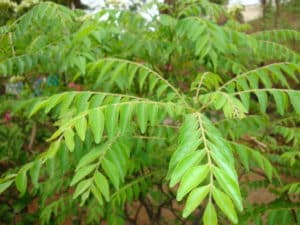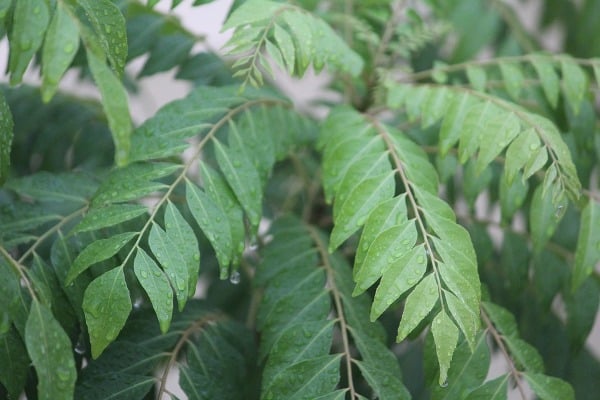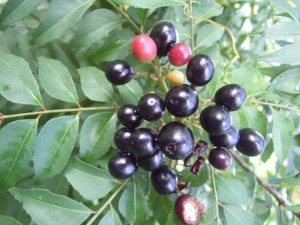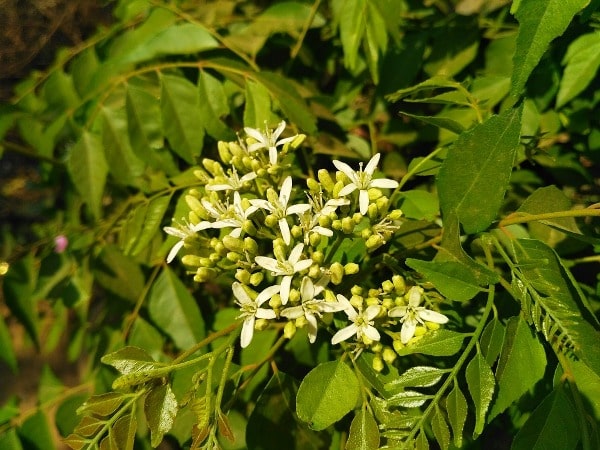Curry Leaves Farming Guide:
The following content explains about Curry leaves Farming.

Introduction to Curry Leaf Plants:
Curry leaves are perhaps one of the highly popular herbs used in India since times immemorial. As the name suggests curry leaves are herbs which are added to curries, stews, soups, legumes, and many such preparations. The nutrients found in curry leaves, per 100 g, include 60 g of moisture, 6 grams of protein, 1 gram of fat, 16 g of carbohydrate, 6 grams of dietary fiber, and 4 grams of minerals such as calcium, phosphorus, iron, nicotinic acid, vitamin A and vitamin C.
Other names of Curry Leaves:
Curry leaves are called by a different name in India like kariveppilai (in Tamil), karivepaku (in Telugu), and karipatta in Hindi.
Varieties of Curry Leaves:
- Sen Kaampa
- Dharwad-1
- Dharwad-2
Best Soil for growing Curry Leaves:
The plant tolerates any soil that is used for foliage plants. Red sandy loam soils with good drainage are ideal for better leaf yield. The optimum temperature requirement is 26° to 37°C. Basically, as a thumb rule, we use 1 part sand, 1 part loam, and 1 part manure. We can also substitute the manure (cow, or other completely decomposed variety) by compost or leaf mold. This plant does not tolerate waterlogging; as soon as it gets too much water, it starts exhibiting yellow leaves.so good draining is important as part of curry leaves farming, keep the soil a bit loose and sandy type.

Read: Biofertilizer Advantages.
Season of sowing and planting of Curry Leaves Plants:
The main season of availability of curry leaf fruits is July – August. Within- 4 days of collection of fruits, the seeds should be pulped and sown in nursery beds or poly bags. One-year-old seedlings are suitable for planting. One seedling is planted at the center of the pit.
Propagation of Curry Leaf Plants:
If you have some very fresh curry leaves, you can try to root some as stem cuttings. Take some of the twigs which are not very floppy and green nor very hard and woody (this stage is called semi-ripe), and remove most of their lower leaves. Cut the stem cleanly at a node, and push the cutting a few centimeters into a 50/50 mix of potting compost and aquarium gravel, with about 3 leaves above the surface. Put the cuttings in a propagator or covered pot, in a warm light place out of direct sunlight. Rooting will take about 3 weeks. in another way, if you find some fresh curry leaves with ripe seeds on you can grow these: they require about 20°C to germinate and may take a long time to germinate. Curry leaf plants are fast growing deciduous shrub which grows well in temperature around 65°C or slightly above. It can be grown successfully either from the seeds or from the stem if proper care is given.

Field preparation for Curry Leaves Plantation:
The field is plowed 3-4 times to get a fine tilth. Before last plowing well-decomposed FYM is applied @ 20 t/ha. Pit size of 30 cm x 30 cm x 30 cm is dug one to two months before planting at a spacing of 1.2 to 1.5 m.
Irrigation requirement for Curry Leaves Plantation:
Immediately after planting the pits are irrigated. On the third day, the second irrigation is given and then the irrigation is given once in a week. Curry leaf plant prefers a well-drained soil to flourish well. So, it is recommended to allow the soil to dry a bit in between each watering session.
Pruning and trimming of Curry Leaf Plants:
It is important to trim your curry leaf plant in order to get a fast and thick growth resulting in better yields. Trimming will provide an ample supply of fresh and young leaves. If you leave the plant without proper trimming, it will outgrow any space easily.
Intercropping in Curry Leaves Crop:

Periodical hoeing and in the first year inter cultivation like pulses can be grown in curry leaves farming. After attaining 1 m height, the terminal bud is cut off to encourage basal branching. In total 5-6 branches are maintained per bush. Ten to twelve months after planting the first harvest starts.
Manures and Fertilizers requirement for Curry Leaf Farming:
Bio-fertilizers are always preferred for the curry leaf plant. After each harvest 20 kg of FYM/plant is applied and mixed with soil. Regular application of fertilizers is more important for plants that are cultivated in pots. Remember not to give a high dose of fertilizers to young plants.
Read: RAS Fish Farming in India; Techniques; Setup.
Pests in Curry Leaves Farming:
- Citrus butterfly
Hand picking and destruction of the larvae and spray Malathian @ 1 ml/ lit.
- Psyllid bug and scale
Psyllid bug and scales can be controlled by spraying Dimethoate @ 1 ml/lit.
Diseases in Curry Leaves Farming:
- Leaf spot
Leaf spot disease can be controlled by spraying Carbendazim @ 1 gram/lit of water. Spraying Sulphur compounds should be avoided.
Harvest and yield of Curry Leaf:
At the end of the first year, 250-400 kg of leaves/ha can be harvested.
1 and 2 years: Once in 4 months every time 1,800 kg/ha which works out to 5,400 kg/ha/year.
3rd year: The yield of 5,400 kg/ha.
4th year: 2,500 kg/ha once in 3 months which would work out to 10,000 kg/ha/year.
From the 5th year onwards: 5,000 kg/ha once in 3 months which work out to 20,000 kg/ha/year.
Marketing of Curry Leaves:
Commercially, Curry leaf has very good demand due to its health benefits and medicinal value and daily usage in India. Transporting to the local market or marketing through dealers is possible.
Bottom Line of growing Curry Leaves:
This is excellent farming with low investment and with good returns.
Read: Growing Tomatoes From Seeds.
I want to know exact details how to sow curry leaves seeds, what’s the procedure? How to pulp the seeds and is it necessary to remove pulp.
We will update Curry Leaves Project Report soon.
Can you suggest sources of curry leaf samplings /seeds for lands in East Godavari district of Andhra Pradesh?
You better search locally from places where the hybrid curry leaf plants are grown.
Sir, we want dharawad-1 and dharawad-2 curry leaves seeds.
I sowed curry seeds from Andhra Pradesh, Rajmandri, last year June last week (2018) but still unable to harvest,,, as my soil is sand mixed, well water drainage, depth is with hard gravel (1 1/2 ‘ft),,,
Veereshgaru you must use good amount of well composted fym and coupled with good quality VAM , PsB , AZATO and KmB – or else Arka Microbial Consortium to get good plant growth under your soil types.
Good luck.
Hi…!
I wanna planing to start a Curry leaves farming
Anyone can help me to guide with full details of flow.
We want to start curry leaf farming in Telangana near Siddipet. Can you suggest the best source of good plants or seeds for planting?
Regards
Rajesh
Hello. I am from Pune but working in Malaysia in a spice company. We produce curry powder and curry leaves are one of the ingredients. Do you think you can export curry leaves flakes (dry and make flakes)? Probably monthly we will import other ingradients such dry as turmeric, coriander seeds, bay leaves etc so curry leaves flakes can go into the same container.
Sir I’m from Sangli Maharashtra I m kadipatta farmer plz guid me for export curry leaves
What are the commercial avenues n benefits if I wish to grow them commercially…who wld be the potential buyers??
Hi Rajesh,
I can supply turmeric, coriander seeds, bay leaves and Curry Leaves
Pls contact